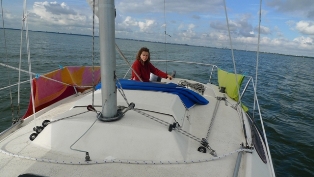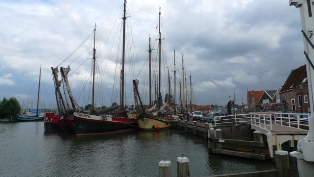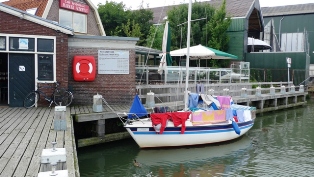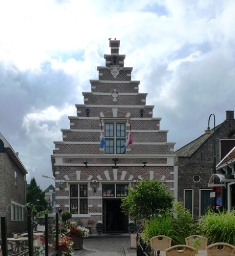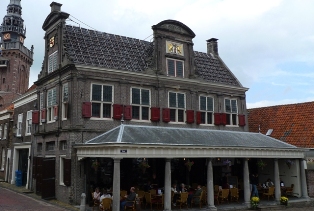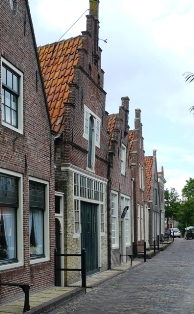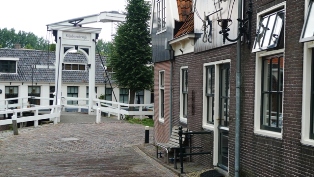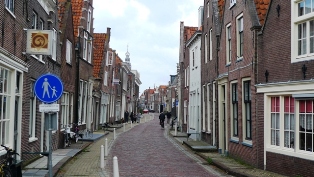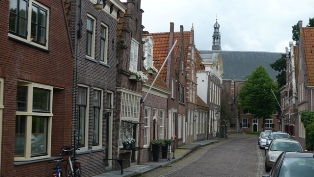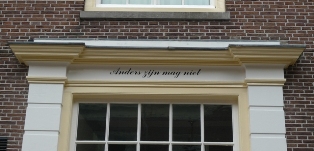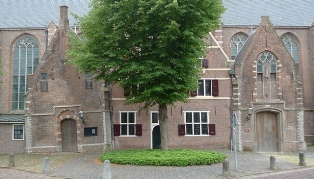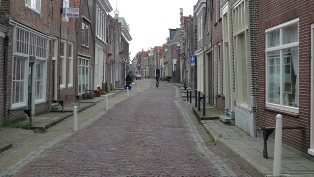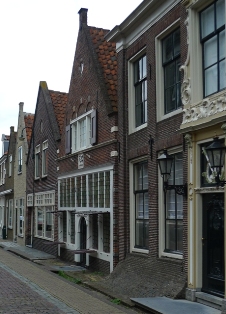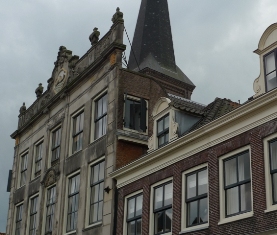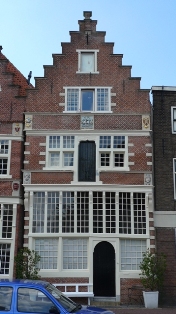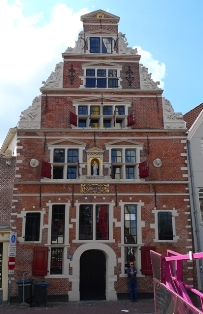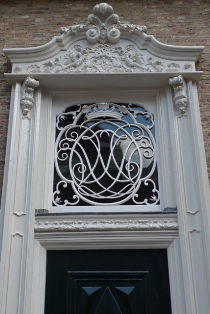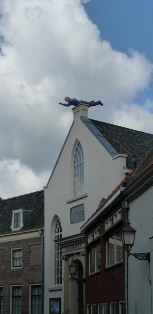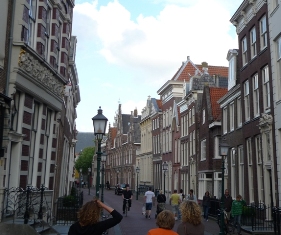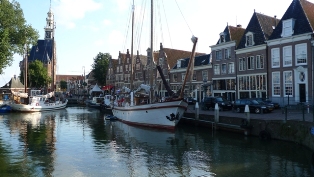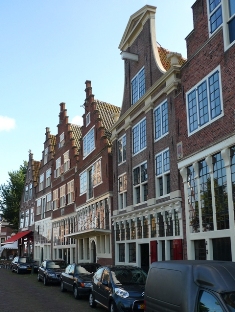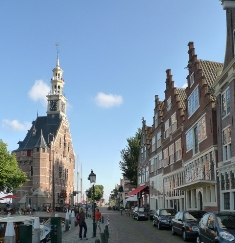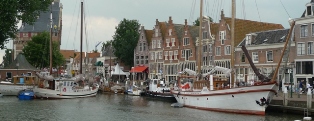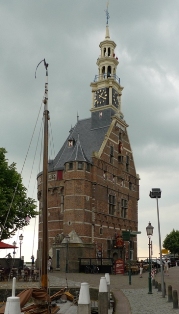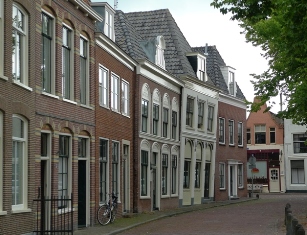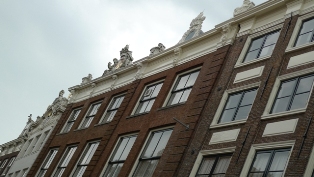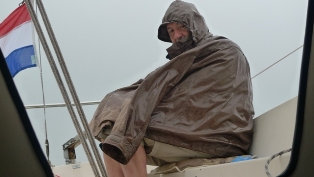Being moved: sailing, ownership and landscape
Carl Friedmann in a collection of her columns written for the newspaper Trouw, entitled Dostoyevski’s umbrella, devoted a number of her columns to her experience of Dutch landscape. The particular column I have in mind is about the polder and is, unremarkably, called De Polder. It is a very moving and beautiful description of landscape, capturing the elusive images of transcendent wish and existential imagination. Unapologetically she builds on clichéd images of horses, cows, crows, meadows, spring, summer and winter; but she makes them her own, knows how to build an atmosphere of longing and loss within the space of a private world strung together from the moments of contemplation that make up the strata of a day. Paul Shepheard has written a fantastic book about the cultivated wilderness, which deals, among other things, with Dutch landscape. I was recently given the Polder Atlas of Holland by my colleagues at the Uni with large photographs from the air revealing the curious grafting of lightly depressed, hollow polderland into the already flat landscape, and visible only as a patched break or tear in the stretched grid of meadows, thickly hemmed by what we call a bosom of water.
Marsman wrote one of his most memorable poems about Holland’s flatness and the two-faced nature of water and I now look at paintings of murky waves and boats with a depth of feeling I had never really thought possible. What is this? Is it a resurgent nationalism? Is it a reaction of my loathing for all the intolerance and petty-mindedness that is swelling up in the populist politics of the day? No, or, at least, I hope not. If it is anything it is a final unremarkable home-coming, a realisation that my life is now fully contained by the country I never knew as a child, and whose fullness was captured in a single romantic book for boys. It is also born of simple gratitude. But that is the uninteresting part. What is interesting is the mechanics of being moved. Being moved requires the standard rigging of mechanics: a force to move something, a thing to be moved, a medium to be moved in and through, another thing to serve as a point of reference so that distance and speed and significant moment in the moving can be established, as well as an observer for things to begin to mean something. Any theoretical difference between moving in one sense and another is hereby declared null and void. I have no need of such a distinction, for the metaphor was well chosen, so well chosen in fact that we call it a metaphor only for convenience. Being moved is a case of being moved, it is a case of movement: if we need a distinction we could call the one effective movement and the other affective movement. Both are subject to mechanics. Of the observer, movement requires experience to take on meaning: a set of projective memories, woven into the cloth of experience in which images, sounds, smells and bodily states connect the world into significant pattern: plays of light, colours and even more fundamentally, a set of familiar and practised bodily movements and tensions, feelings of fresh humidity the skin perhaps, but also the working of the landscape as a frame of reference for one’s activity within it, senses of muscular tension, the sense of horizontality or the slant of one’s bodily weight, the proprioceptive delight of coordinated movement. It also requires an extra sensitivity to directions of winds, light, warmth. It is all this which allows a situation to be recognised, compared, related, measured and made to mean something. It is because memory is a multiplicity of tags and movements that mirror the world, that it is able to recognise a situation as painted in words or described in pictures. It is as if the movements, sensations and imaginings of what one has done oneself or would wish to, are conjured up and find their echo in the words and the paint forming an assemblage with them and making them uniquely yours, making them fill you out as a product of life: me. These paintings, poems and essays about the landscape are not the mirror of something that has happened or of something that is over there, but rather they form an intimate assemblage with one’s own experience, creating an offspring environment: the environment that one can own as peculiarly yours upon which these feelings memories of movement and force can recharge and which you can use to make the arrangements that are life.
Very faintly in the back of my mind is an image of young men from Hoorn skating home over the frozen waterways of North Holland after their adventures in Indonesia on a VOC ship skippered by Captain Bontekoe (colourful cow or furry cow depending on which meaning you take for bont). I know precisely how many times I have read that book. I kept count. I may have erred on the side of caution. Anyway, I used to sail on other people’s boats when I was a young teenager and felt then the strong but powerless hull of the boat relentlessly being pounded by the waves. Later on, as a student, I sailed in small dinghies with my large-scale student friends. We would lazily crisscross the Kaag, just north of Leiden with a bottle of gin or cheap beer or whatever was at hand, bantering, making each other laugh or just sitting quietly, letting the breeze play and the birds do their thing. I was happy in my subordinate role as jib-boy, I could concentrate on what I was best at: dreaming, drinking, laughing, watching the odd cormorant doing its odd things, like submerging its body too deeply in the water to be considered a proper self-respecting bird and hanging its awkward wings out to dry in a gesture of submission to evolution. Sometimes the wind would pick up and there would happen an unspoken and miraculous magnetic coordination in our actions which would gradually diffuse again as things quietened down. Once Eric and I nearly collided with a river barge much, much bigger than our tiny little Valk. It came up close while we were talking away and made us jump out of our skins when it sounded its horn and we turned our heads and saw it looming up, its wide bow seemingly winged like a figure of death. We just managed to hold the barge off and gently “walk” our dinghy along its black rough side letting it pass back into oblivion. It was a near miss, Eric was white as a sheet. I had not fully understood the danger and had just accepted that such things happened and had quite forgotten the incident until recently when it became necessary to dig up these stories. I did not own a boat then. Danger is about things you understand the size and potential of, danger requires ownership of the danger. It was not that I was irresponsible or couldn’t care less about other people’s property. Quite the contrary; I have perhaps an exaggerated sense of responsibility. It was just that the danger was not fully part of me, I did not have the requisite experience to imagine what this incident had been about.
A few years ago my brother-in-law David bought a dinghy in Dorset and a little later a dear friend in Holland, Rick bought a small yacht and regularly sent me advertisements of second- and third-hand boats for sale on the internet. Paul had a boat, as did Eric. I successfully ignored them all, I didn’t have the money. It was all so simple. In June things started to conspire against me. It started when I bought a painting for the ridiculous sum of 3 euro’s. I had come across it in our local market and liked it. When Victoria also liked it we gave it pride position and hung it above the mantelpiece in the music room. It presents two boats, a black clipper further back to the right, sailing towards the left of the picture and a smaller sailing vessel with all its white sails bellowing, sailing down from left to right in the foreground over an elegantly stylised sea. In the background you can see a vague coastline with rolling hills and a lighthouse. Not the coast of Holland then, I hear you think. But that is not necessarily the case. We have our dunes. The smaller boat is definitely Dutch; the larger black boat, a three master, carries a black or dark blue flag with a white cross. I asked my other brother-in-law Reino, an acknowledged sail expert and renowned knowledge archaeologist, what he made of the flag. Was it Cornish, Swedish, he couldn’t decide. The flag was too blue to be a Cornish flag and the cross too white to be a Swedish flag and the name of the boat to Dutch or Scandinavian to be English. The next thing that happened was that the mother of Joshua’s best friend phoned up and asked whether Joshua might like to do sailing lessons with her boy. Yes, that would be wonderful so we arranged that and carried on with life, still completely unaware that the Gods had quite made up their mind. Then one day Rick sent me another one of his advertisement at the beginning of July, just before I was due to leave for Amman; it was for a Kelt, a polyester yacht of six metres with a tiny cabin sleeping a maximum of four. I would have clicked it away heroically but for the fact that Victoria was just coming down the stairs and into the study so I showed her the boat, more as evidence of Rick’s marvellous tenacity than anything else. In financial terms this visit to my study by my wife was disastrous. The man selling the boat was a nice Friesian chap and a very experienced salesman indeed who made the thing sound such a good bargain that we couldn’t let it go. I was the first of a whole string of interested people, or so at least he said. I still believe him. It was a good bargain. Rick and I went up to Friesland to inspect it thoroughly and the next day I had spent all our holiday money. Fate. It was brought down to the Kaag all the way from Friesland by the salesman’s dad and brought to a small harbour in Rijpwetering.
In a short space of time I learnt all about anti-fouling and other such delights and within a week the boat was back in the water looking like a... well, a... and old polyester sailing yacht of very small size, needing a lot of care and love. I was now the owner of a boat. I knew ownership of course. I own the mortgage to a house, a car, things, memories. Apart from owning things I also have things. I have a wife, children, a weightproblem. These things I own in a slightly different way to the way I own my boat and my car. Both require care, proper and loving use, that much they have in common. After much lively discussion we kept the name it had been given probably by the last owners: Klak. The letters had been indifferently printed on special stickers which, in turn, had been stuck onto the prow of the boat. The first owners had given it the improbable name of RudolV which had been engraved on a plate which could no longer be safely removed from the stern of the boat. So the boat now had a name and an echo-name. I liked Klak. It is simple and has a clear, neatly cut sound to it, the two k’s sounding like taps of the heal on a hard surface. It felt like the kind of sound one would want when writing a haiku about place and season. Reminders of the boats age and history abound on its surface and yet it is not a historical yacht, it is a small polyester thing merely showing the signs of good and bad use.
So here we are set for what I want to talk about. Sailing, ownership and landscape. We spent the first weeks of July just mucking about on the Kaag, practising the movements and perfecting and adjusting the bits and pieces, making the boat our own by changing its arrangements, cleaning it lovingly, repairing what could be repaired and wondering about things that couldn’t and then trying to ignore them. This is where ownership is an effort to extend the I to include objects and events that do not strictly belong to the body it governs. Coming in and out of the narrow harbour was very frightening at first, especially when the wind came from the north or east. And when you own a boat, the boat and you become fused in people’s minds; that boat is you, it is yours; yours to claim the privilege of use but also a representative of you and your clumsiness. Its behaviour is your behaviour. Making a mess of the mooring, not quite getting the knots and rigging right, all these things suddenly become signs of me in my totality. My initial incompetence or at least my unfamiliarity articulated me as a public persona within that small universe of the harbour. But soon things settled down, within a week I had practised things and had become reasonably skilled and familiar with the boat as a compound of activities that one has to perform and things one has to feel and know in order to respond adequately. The knots still had to be practised, but even they have now settled and my ownership of the boat has become invisible. Perhaps that is not quite the right word. My ownership has not become so much invisible as without charge. It is no longer the boat of that new chap, that man who had difficulty with getting his boat into the harbour, it is now just another boat with an owner. Now, at this point it has to be said that it wasn’t other people who made me feel this way. Only two of them ever saw me make a mess of things, and the mess wasn’t all that bad. Nothing happened. It was all me, me in the imagined eyes of others. I do have experience of others. When Sartre said that Hell is other people in Huis Clos, he might well have understood that the hell created by other people is in the first instance the hell one creates for oneself heterologically, that is by imaging what other people might think and say. The other is all too often a product of mirrors. That is the real hell one makes for oneself. So often I find my judgement of how other people judge me as grossly exaggerated, paranoid even and unkind. I get people wrong, often. I am graceless.
Then, towards the end of the month Joshua (who had just completed sailing camp) and I were to take the boat along the Standing Mast Route (Staande Mast Route), from the Kaag to the Markermeer. There, after a few days Victoria and Rosie would join us. And this is what happened. I was exceedingly nervous of the journey to and through Amsterdam, not knowing what to expect and feeling still as if I did not know the boat well enough, or rather trust my own abilities well enough. I had consulted a student of mine, Richard, who is a sailing instructor. He very kindly gave me all sorts of tips and internet links and such so that I was at least able to swot up on the history and theory of it, something that always makes me feel more comfortable. But doing the thing requires more. We spent the night on the Kever, which is quite the most delightful of the lakes making up the Kaag, with a classic view of a deep polder behind a dyke, the steeple of Rijpwetering in the distance and a series of old mills set off against the large expanse of darkening sky full of posturing clouds of brilliant yellow, blue gray and wisps of white. That night Joshua and I discovered that the name of the boat was perfectly chosen, we were right to keep it. Klak, is the noise the water makes as it gently pats the hull just before you go to sleep. Joshua was reading his Harry Potter and I was reading a Ruth Rendel. We went to bed, he in the front and me in the main cabin. I awoke a 6.30 and took a plunge in the cold murky water, dried myself, started the motor and lifted anchor. We had lowered the mast the day before and so we set off with a slightly messy looking boat with its stays, halliards and sundry bits and pieces distributed over the deck in improbable lines. It is now four weeks later and yet I still feel the air on my face and see the greens of the willow trees and the poplars and the weird colour of the water, with its strange shapes expanding and contracting as ripples, I feel the push of the mast as I struggle to stand straight, the corners and notches softly nudging my thigh or calves. It was a beautiful day. A slight haze hung over the water and the lower meadows. The cows looked acceptant. We went onto the main waterway lying higher than the surrounding land and cruised along listening to the insistent but harmless putter of the engine. Soon we took the aqueduct crossing the A4 motorway connecting The Hague and Amsterdam, seeing the traffic dive under us. We went past Schiphol where the scale of the landscape changed, the bridges became tall, the buildings immense and faceless, the acoustics eerie and hollow. Until then the waterway was lined almost along its full length with houses, all of them sprouting their own little quays and jetty’s holding all manner of boats to muck around with. The Standing Mast Route is something of a feature in boating Holland, it allows largish ships with their standing rigging to travel the full length of the country from Maastricht to Delfzijl and Den Helder. A lot of boats follow the route with their mast standing, although it naturally takes you much longer as you have to wait at almost every bridge. Through Amsterdam they do it in convoy and the bridge attendant cycles along to service each bridge in turn as the line of boats moves along. During the busy summer the sailing yachts have to wait until eleven o’clock at night to pass through the canals of Amsterdam, which, though beautiful and spectacular, makes it worth taking the mast down and doing things at your own pace.
By ten o’clock we had arrived at the Riekermeer which marks the beginning of the route through Amsterdam. I had my first experience with a sluice and then we powered through the Kostverlorenkade (How to translate that.... kost, depending on the context, means cost, charge, expense, but it also means a living, livelihood in the sense of our daily bread. Kost verloren thus means lost livelihood or lost expenses. The quay of lost livelihood...) I do not yet know the reason behind the name but will look it up one day. Anyway the canal forms a tangent to the hoof-shaped canal network which characterizes old Amsterdam and joins the main waterway, the IJ to the west of Amsterdam which meant we had to travel with our tiny boat through the choppy waters of the IJ competing with gigantic tugboats, liners, barges, you name it. Having felt quite sizeable on the Kaag, where the dinghies measured themselves against us, we suddenly felt tiny and lost in the enormous scale of Amsterdam’s harbour. Even so it was exciting to pass behind Central Station and to look at all the familiar landmarks of Amsterdam from the low level of the water, making everything around us appear tall and leaning over. Confused by a sign, I moored the boat near a bridgemaster’s office and asked the man who had kindly come out to meet me what I should do. He was most helpful, telling us to just carry on as we were, making sure we kept well starboard as the big ships do not like having to take account of the smaller ones. And so we passed from the West of Amsterdam to the East over the water which was now decidedly grey and sharp, choppy in fact. We felt like Skippy the tugboat on his adventure. Towards the West of Amsterdam we crossed to Portside and arrived at the Orange Sluices. These are serious sluices, gigantic to us and we entered with some twenty other sailing and motoring yachts. I felt a light panic but we did our thing and were helped by a very kind gentleman with gray tufts of hair who was hoisted up in wonderful looking safety gear. He told us with a quiet voice that we could moor alongside his boat. He had that stoic military calm about him, the calm that Tolstoy likes to see in his generals, making every crisis dissolve in his confidence, and helped us shore our boat to his fifteen metre yacht which he had just sailed single-handedly from England. He looked at my jibsheets and told us it was never a good idea to put a knot in a sheet as it might get stuck somewhere and cause a problem. We were duly impressed and felt released from a danger that had not even revealed itself to us.
We emerged from the orange sluices unscathed and having caused no one any harm, for which we were thankful and soon the IJ broadened into the IJmeer. On the advice of our intrepid admiral (more appropriate than general) we set course for Durgerdam, a single string of houses built against the dyke and dropped our anchor in the outer harbour. There we spent a tense hour or two raising the mast with just the two of us. Josh performed brilliantly. Having got everything shipshape we approached the little harbour intending to do some shopping and were met by a very kind assistant harbourmaster who told us there were no shops in Durgerdam and we would have to set sail for Muiden. Sailing was out of the question as with the raising of the mast I had allowed a crucial pin holding one of the stays, to fall into the water. I couldn’t trust the mast to hold without this second stay so we decided to motor. The wind was strong and the waves huge. Motoring in the same direction as the wind meant that we surfed each wave and were glad we hadn’t felt the need to try sailing.
Arriving in Muiden is wonderful. You pass Pampus, a small island in the middle of the IJmeer which plays a large role in the Dutch language as the expression, voor Pampus liggen (to lie in front of Pampus) means to be out cold, or paralytic, or without any will to do anything. Pampus used to be just a sandbank which, when the IJsselmeer was still open to the north sea and called the Zuiderzee, would prevent ships either leaving or entering Amsterdam at low water. So it was fun passing the real thing as it were. Having passed Pampus, you get a clear view of the castle of Muiden making it easy to determine your course. We moored along the quay near the sluice gates and felt extremely elated and grateful at having brought the first day of this soul expanding adventure to a successful end. I managed to do my shopping, buying my pin and so we repaired the stay and prepared for the night.
The next day we emerged from the groynes protecting the harbour of Muiden, motored past the castle and were overtaken by a fleet of Olympia Jols on their way to a race. I commented on the fact that the boat next to us was sailing faster than we were motoring and the girl enthusiastically told us that they had done 5 knots in the wind yesterday. Her cheeks were flushed and her skill in handling the boat immediately apparent. We smiled, wondering how fast that was. I looked it up, a knot is 1 nautical mile, is 1.85 kilometres, making 5 knots just above 9 kilometres an hour, a fast jog more or less. Sailing obviously requires a different conception of speed. The fast of a ship is slow for a bicycle. I had to reconceive my sense of the fast. And this would have been no problem had I not looked up what a knot properly represented. We hoisted our sails and set off northwards, avoiding the racing jols who needed their space. What an experience! It was our first sailing experience in our new boat on such an open expanse of water. The Kaag is about relative distance to the coast, it is about extremely pretty postage stamp views and the potential danger of other boats in the vicinity. Here it was about waves, complex movements, the colour and rush of water and foam, the stretch of the horizon and the strange behaviour of trees and church towers when they hover over the horizon like floating islands over the water. It was about the distant view of huge sails and above all it was about measurelessness. To starboard we had the giant windmills on the coast of Flevoland doing their surreal thing, to port we had the lines and complicated patterns of Amsterdam slowly receding, but above all we had our own boat, full of wind, playing and dancing on the surface of the water which looked what air full of sound must look like, full of complex wave structures. When, after hours, we had had enough, we turned around and set sail for Almere Haven in the Randmeren. There we moored in the harbour and were accosted by an experienced sailor who had taken pity on us and told us how to moor our boat properly using the most complicated knot he could muster. Almere Haven is not pretty but very comfortable and easy to get to. We spent a few days sailing in the lakes there and awaited the arrival of Rosie and Victoria. When they came aboard we sailed first to Durgerdam, then to Volendam, which was hateful and depressing. We then moved to Monnickendam which was as delightful as Volendam had been horrible and we spent two delightful if rather wet days there reading books and enjoying the perspective of streets and buildings there. We then sailed on to Hoorn and spent a few days there doing much the same as well as celebrating Rosie’s birthday. After that we returned home dropping Victoria off at Central Station in Amsterdam and motoring all the way back to the Kaag. What a time. What a pleasure to own a boat, to determine its route, to feel its behaviour and responding to it, to become an assemblage with it, an organised body, an organism, to feel it as the absolute centre of one’s world as one travels about. To feel the expansion of the world around you as you move. Despite the confined space of the boat itself, one does not feel confined because it works much like a balcony in a theatre. A boat is a balcony onto the world.
Denkend aan Holland
zie ik breede rivieren
traag door oneindig
laagland gaan,
rijen ondenkbaar
ijle populieren
als hooge pluimen
aan den einder staan;
en in de geweldige
ruimte verzonken
de boerderijen
verspreid door het land,
boomgroepen, dorpen,
geknotte torens,
kerken en olmen
in een grootsch verband.
de lucht hangt er laag
en de zon wordt er langzaam
in grijze veelkleurige
dampen gesmoord,
en in alle gewesten
wordt de stem van het water
met zijn eeuwige rampen
gevreesd en gehoord.
Hendrik Marsman
Thinking of Holland
I see broad rivers
slowly passing
through infinite lowland
rows of unthinkably
slim poplars
like plumes
standing high on the horizon
and submerged within
a tremendous space
the farms
spread through the land,
copses, villages,
pollarded towers,
churches and elms
in a great bond
the sky hangs low
and the sun is slowly
stifled by the manicoloured
steamy grays
and in all parts
the voice of the water
with its eternal disasters
is feared and heard
a literal translation as the music is never retained in translation, becoming new music ousting the old. so here is a tranlsation without music to leave the music of the original in tact at least for those who can enjoy it.
